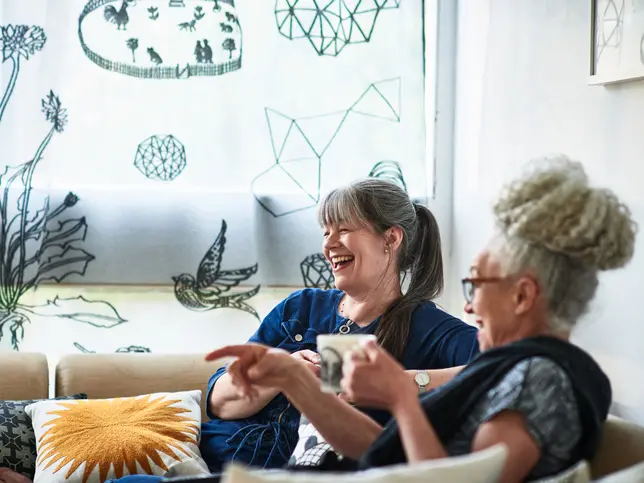8 tips to listen better and improve your relationships
Listening well is an art that entails recognizing and respecting people’s emotions and values. Making the effort benefits both them and you.

It’s wonderful when you have a chance to really listen to somebody and help them feel heard and valued.
“The difference between the sense of hearing and the skill of listening is attention,” explains auditory neuroscientist Seth Horowitz. While hearing is easy, “listening, really listening, is hard when potential distractions are leaping into your ears every fifty-thousandth of a second.”
These days, we are more distracted than ever by text messages, email and technology — even our cars talk to us! Giving someone our full attention can take concerted effort, but it is well worth it. Learning how to listen better to others improves your relationships at work and home, boosting your social wellness and decreasing stress.
The art of listening well can be learned and practiced. In her book Talk RX, physician and corporate communication expert Neha Sangwan identifies five levels of listening, from impersonal to deeply connected:
- At the baseline is closed listening, when you’re distracted, bored or merely pretending to be listening. You are probably using closed body language, too — crossed arms and legs, no direct eye contact, answering only with monosyllables.
- Next is head listening, when the listener focuses more on their own experiences and thoughts than what the speaker is saying. Head listeners often rehearse in their head what they are going to say next before the speaker is finished. They listen to a sound bite of what the other person is saying, then jump to how it relates to them.
- Ear listening happens when the listener really pays attention to the words being spoken and their meaning. They are gathering data and focusing on details. Listening at this level is valuable and can help with problem-solving and giving advice.
- For even better communication and relationships, try heart listening, listening for the emotions underneath the words being spoken. Pay attention to tone and body language and how the information is delivered.
- At the top level is open listening. An open listener pays attention to words and emotions and also considers the speaker’s values and what is important to that individual.
“If you shift into a higher level of listening, one that seeks to recognize emotions and values, you have the potential to create a bridge of understanding rather than a divide,” Sangwan says.
Here are eight tips for more skilled listening:
Give your full attention. Don’t look at your phone; put away distracting electronic devices. Try to assume an open body posture. Listen for details that you can ask questions about or comment on later.
Ask questions. Request further details, draw out a story and show your interest. Even if the subject of the conversation isn’t interesting to you, you can find out what it means to the speaker by asking questions. “How do you feel about that?” “How long did that take?” “What will you do next?”
Make eye contact. Looking at someone’s eyes while they talk to you can help them feel understood and can give you clues about their emotions. It is worth noting, however, that eye contact rules for conversations can be cultural; some cultures consider full eye contact impolite in certain situations. Also, people with autism may feel uncomfortable with direct eye contact. Therefore, do not assume that if someone is not looking you in the eye, they are not listening.
Give the gift of silence. Listening often means being quiet and waiting. It’s important to allow the speaker time to think and respond to your questions. Be patient! Try to get comfortable with the silence while you wait.
Repeat what has been said. Repeating what someone said now and then can show you are listening. Communication experts say you don’t need to repeat the whole thing; just repeat the last few words to show you are following.
Comment before continuing. If you find yourself already formulating what you are going to say before the speaker is finished (head listening), hold that thought. Also, don’t talk over or interrupt the speaker. While it’s natural to want to share your own experiences, it can backfire if the other person doesn’t feel heard first. Listen attentively and comment on what the speaker says so the person feels heard before you share.
Address emotions. If someone seems upset, elated, frustrated or even angry, just commenting on the facts probably won’t be enough to make the speaker feel heard or cared about. When strong emotions are present, it’s OK to ask or comment about them. Anything from “That sounds hard” to “Are you OK?” can help your speaker feel acknowledged.
Value their values. You don’t have to agree with someone about what’s important in life to be able to acknowledge their values. Your teenager’s missing favorite shirt may not seem like the crisis to you that it does to him, but saying, “I can see how important this is to you” can help him feel heard. If you don’t see the significance right away, ask. For example, you can learn a lot from a colleague after a presentation by asking, “Why is this important to you (or to our organization)?”
Remember, staying fully engaged when having a conversation with someone will help that individual feel listened to, heard and valued. The better listener you become, the better relationships you will cultivate, and the more satisfied you will be with your social wellness.



